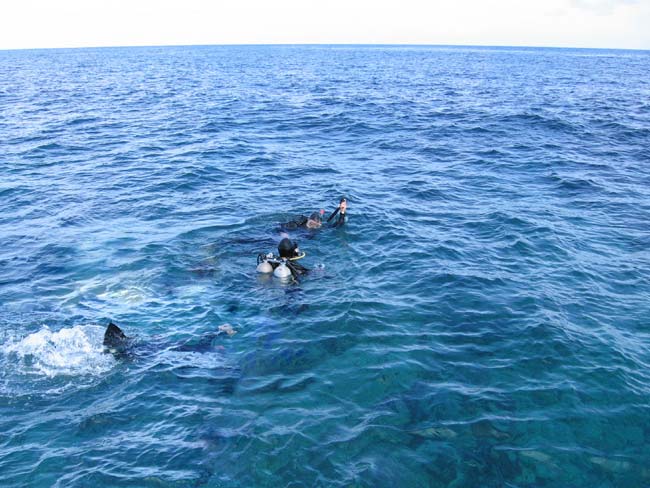
Soon a large fin appeared among them and it was clear as we dropped to the 60- foot bottom that the sharks were here.
SHARK DIVING EXPEDITION
I have always been fascinated by the undersea world and, as you can see
from the other links in this section, much of my diving has been involved in
locating and recovering the early Atlantic submarine telegraph cables which
linked, for the very first time, the United States and other countries in the
world.
I have also been fascinated by the behavior of the sharks that I encountered
during my dives. On a trip to the Island of Abaco in the Bahamas, I decided
to ask local divemaster Tim Higgs of Abaco Dive Adventures:
(http://www.abacodivers.com)
to take me on a trip to observe the behavior of as many sharks as possible.
I had dived with Tim the previous year when he took me into an extraordinary
Bahamian Blue Hole to see the elaborate underwater stalactites and the blind
eyeless cave fish. I consider Tim to be the best divemaster with whom I have
ever dived in over 600 dives and I knew the trip would be memorable since he
specializes in catering dive adventures to the needs and capabilities of his
many clients.
The brief trip to the reef brought us to an area with excellent visibility and
many fish.
Tim brought along a good supply of raw fish to feed to the small fish
and they were soon swarming around the boat. Tim does not believe in feeding
the shark directly but has found from experience that the well-fed smaller
fish attract the sharks very effectively.

Soon a large fin appeared among them and it was clear as we dropped to the 60-
foot bottom that the sharks were here.

Tim took this photo of me as I adjusted my camera unaware of the shark peering
over my shoulder.
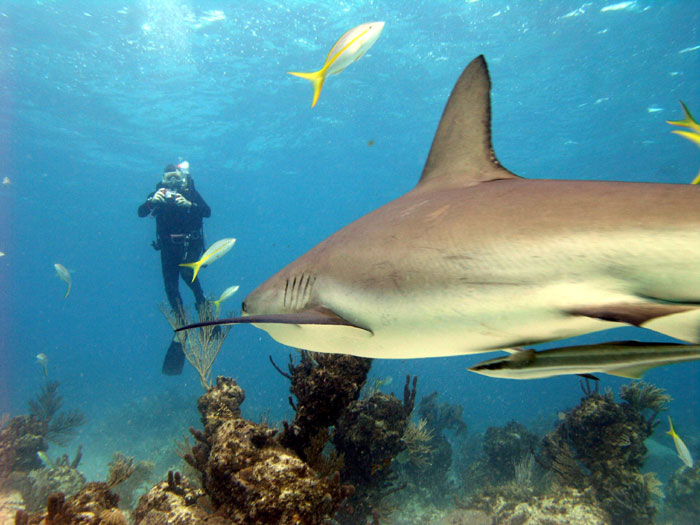
Tim continued to take photos of me as I took photos of the sharks and watched
very carefully for any signs that they were preparing to attack us.
It was apparent that the sharks were very curious about us and that they were
considering whether we would taste good but they generally remained at a
distance of a few feet as they circled us continually and watchfully. I was
able to reach out and touch several of them without producing any noticeable
reaction as they continued their inspection. Tim warned me, however, that
stirring up sand with my fins would attract a great deal of attention from
the sharks since much of their natural prey also stirs up sand.
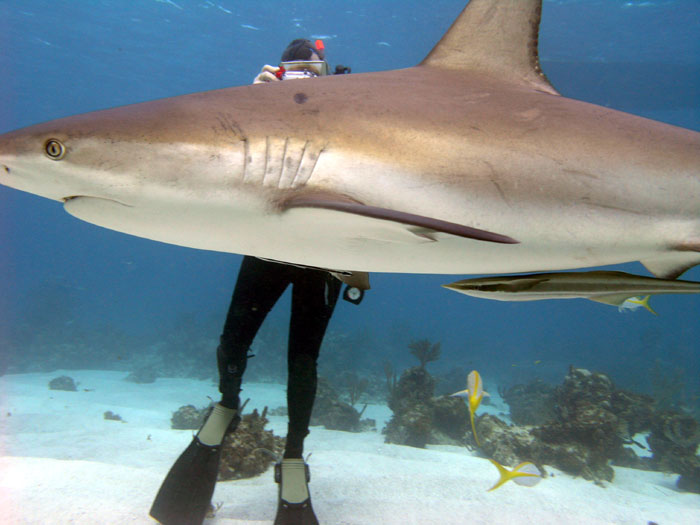

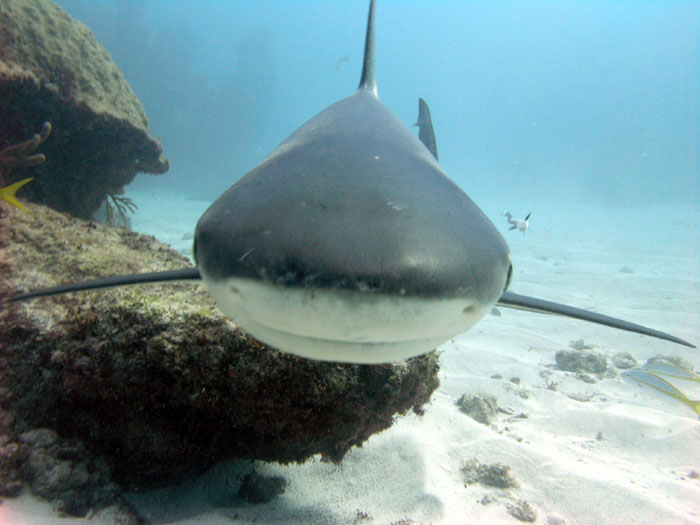
My photographs did not come out as well as Tim's but they do show some pretty
large sharks.

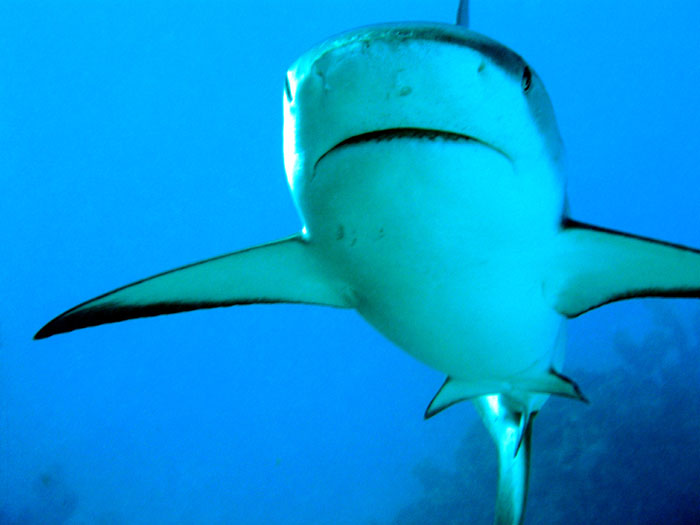
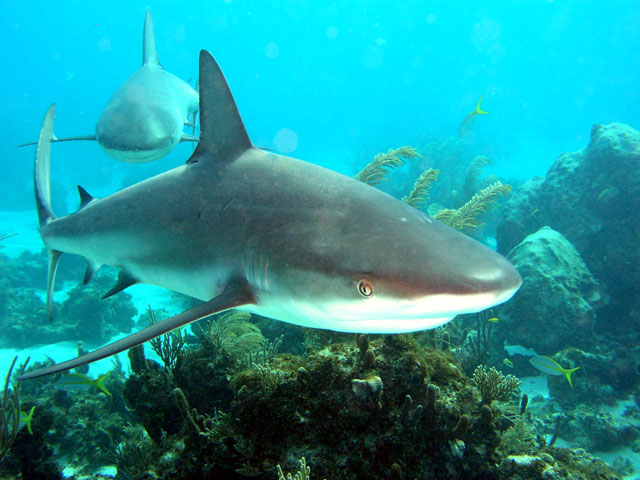

At one point during our two hour-long dives, a shark began to become more
than a little curious about Tim who responded by assuming a rather aggressive
posture.
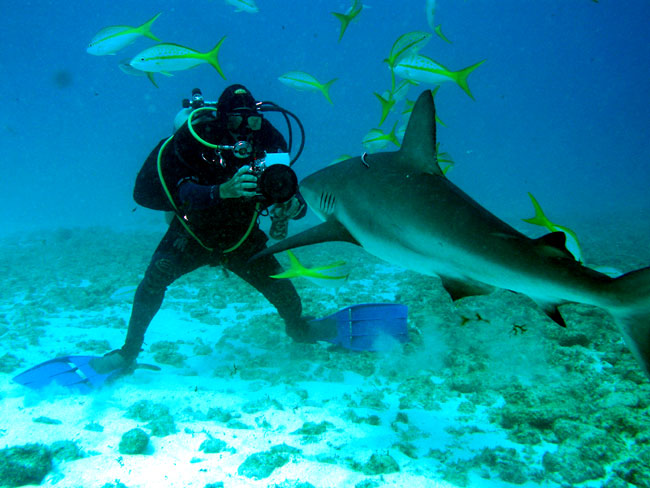
Tim finally had to hit the shark rather sharply on it's nose with the lens of
his camera which he brandished when necessary.
People often ask about the danger posed by sharks. As shark protection during
my early diving in the 1950s, I carried the military surplus World War II
shark repellent packages of dye. Their effectiveness was questionable and
when the Farallon "Shark Dart" came on the market, I bought two of them and
have carried one on every dive since then.

The Farallon "Shark Dart" consists of a sharpened hollow spike with a high
pressure Carbon Dioxide cylinder at one end. When you poke the spike into a
shark, a sharp pin is supposed to puncture the cylinder and the gas travels
out the hollow spike and into the shark. The gas inflates the shark like a
balloon and it is forced to the surface where it can do no harm.
I only had to actually draw the dart on one occasion during which I lunged at
an attacking Bull Shark with it and the shark instantly turned away and was
gone. Shark are not used to having their "prey" attack them. As a result, I
have never seen whether the dart can actually protect a diver as it is
supposed to do.
Internet ENIGMA Museum:
https://EnigmaMuseum.com
COPYRIGHT NOTICE: (Copyright (c) 2023: Prof. Tom Perera Ph. D.)
Although all the pictures and text are copyrighted, you may use any of them
for your own personal applications including public lectures and
demonstrations, publications and websites as long as you mention the
w1tp.com Museum. If you plan to offer them for sale to the public
in any form, please email me for permission which I will generally grant as
long as you mention my museum: http://w1tp.com or https://EnigmaMuseum.com My email address is
given at the bottom of this page. Some of the material may require contacting
other copyright owners for commercial use and I will inform you by email.
Please also see the Disclaimer of Warranty.